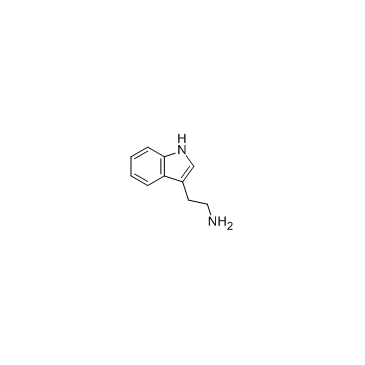| Description |
N-Salicyloyltryptamine acts on voltage-dependent Na+, Ca2+, and K+ ion channels inhibitor. N-Salicyloyltryptamine inhibits K+ currents with an IC50 value of 34.6 μM (Ito). N-Salicyloyltryptamine also exhibits anticonvulsant, anti-inflammatory, analgesic, and vasorelaxation effect[1]-[5].
|
| Related Catalog |
|
| Target |
L-type calcium channel
potassium channel:34.6 μM (IC50)
|
| In Vitro |
N-Salicyloyltryptamine (1 ng/mL-1 μg/mL; 24 h) presents no cytotoxicity and causes no oxidative stress in RAW 264.7 cells at low concentration, but (50 and 100 μg/mL) inhibits cell viability with an IC50 value of 22.75 μg/mL[1]. N-Salicyloyltryptamine (1 μg/mL; 24 h) reverses some redox and inflammatory parameters induced by LPS without interfering in cell viability[1]. N-Salicyloyltryptamine (1 μg/mL; 24 h) inhibits LPS-induced TNF-α and IL-1β release, as well as CD40 and TNF-α protein up-regulation[1]. N-Salicyloyltryptamine (1 μg/mL; 24 h) inhibits phosphorylation of ERK 1/2 and IκBα and p65 nuclear translocation (NF-kB activation)[1]. N-Salicyloyltryptamine (17 μM) inhibits K+ current by 59.27% (Ito) and 73.18% (IKD), inhibits L-type Ca2+ currents by 54.9%, and shows few inhibition with high concentration (170 μM) on TTX-sensitive Na+ current by 22.1% in GH3 cells[2]. N-Salicyloyltryptamine (0.01 nM-100 µM) produces vasorelaxation through activation of the NO/sGC/cGMP pathway and reduction of calcium influx[3]. Cell Viability Assay[1] Cell Line: RAW 264.7 cell Concentration: 0.001, 0.05, 1, 50, 100 μg/mL Incubation Time: 24 hours Result: Resulted no effect on RAW 264.7 cell viability at 1 μg/mL; however, concentrations of 50 and 100 μg/mL significantly decreased both MTT reduction and SRB incorporation. RT-PCR[1] Cell Line: RAW 264.7 cell Concentration: 1 μg/mL Incubation Time: 24 hours Result: Reduced CD40, TNF-α, and RAGE immunocontent. Inhibited ERK1/2 and IκBα phosphorylation and nuclear translocation of p65.
|
| In Vivo |
N-Salicyloyltryptamine (100 mg/kg; i.p.; 60 min before stimulation challenge) significantly inhibits pentylenetetrazol (PTZ)-induced seizures and partially eliminates the extensor reflex of maximal electric-induced seizures test[4]. N-Salicyloyltryptamine (100 mg/kg, 200 mg/kg; i.p.; single dose) shows antinociceptive and nerve excitability effects[5]. Animal Model: Male Swiss mice (25-35 g)[4] Dosage: 50, 100, 200 mg/kg Administration: Intraperitoneal injection; single dose; 60 min before stimulation challenge Result: Reduced the incidence of clonic pentylenetetrazol (PTZ) seizures and mortality at 50 mg/kg, and decreased the incidence of tonic hindlimb extension (THE) produced by MES at 100, 200 mg/kg. Animal Model: Male Swiss mice (25-35 g)[5] Dosage: 100 mg/kg; 200 mg/kg Administration: Intraperitoneal injection; single dose Result: Reduced the acetic acid-induced licking response of the injected paw.
|
| References |
[1]. Gasparotto J, et al Effect of N-salicyloyltryptamine (STP), a novel tryptamine analogue, on parameters of cell viability, oxidative stress, and immunomodulation in RAW 264.7 macrophages. Cell Biol Toxicol. 2013 Jun;29(3):175-87. [2]. Araújo DA, et al. N-salicyloyltryptamine, a new anticonvulsant drug, acts on voltage-dependent Na+, Ca2+, and K+ ion channels. Br J Pharmacol. 2003 Dec;140(7):1331-9. [3]. Veras RC, et al. N-Salicyloyltryptamine, an N-Benzoyltryptamine Analogue, Induces Vasorelaxation through Activation of the NO/sGC Pathway and Reduction of Calcium Influx. Molecules. 2018 Jan 28;23(2):253. [4]. Oliveira FA, et al. Anticonvulsant properties of N-salicyloyltryptamine in mice. Pharmacol Biochem Behav. 2001 Feb;68(2):199-202. [5]. Quintans LJ Jr, et al. Bioassay-guided evaluation of antinociceptive effect of N-salicyloyltryptamine: a behavioral and electrophysiological approach. J Biomed Biotechnol. 2010;2010:230745.
|


